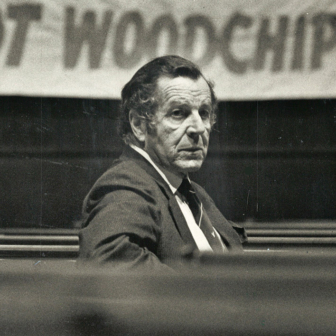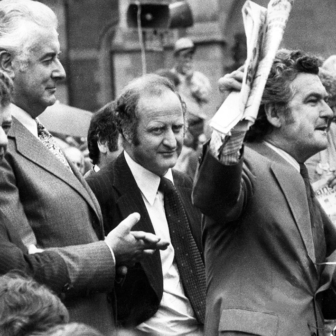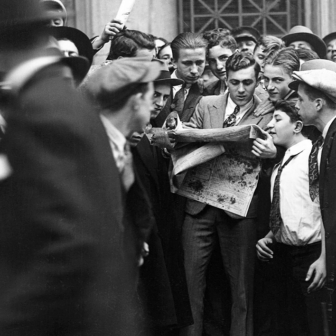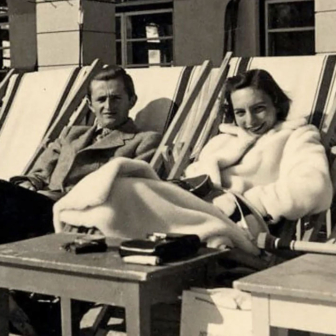First published December 2011
In May, when journalists at Fairfax newspapers wrote a petition to their chairman, Roger Corbett, against plans to cut sub-editing staff, artists and designers, the main point they made was this: “To remove production from these newspapers is to cut the heart from them, removing the history and institutional memory that sets Fairfax newspapers apart from the rest of the media.”
The journalists and their union were objecting to Fairfax Media’s decision to outsource much of the sub-editing of news on their metropolitan dailies to Pagemasters. Staff I’ve talked to at Fairfax’s Melbourne paper, the Age, including house committee members, say that because the move was only implemented in June it’s still too early to tell what impact the changes will have, especially in Melbourne, where far more Fairfax subs took up jobs with Pagemasters. There is a cadre of subs at Pagemasters who still understand the Age’s editorial identity, style and values, and feel a connection with the paper and their former colleagues. At present, the job they do is carefully monitored by the chief sub back at the office, and by page editors.
So, you might say, what’s the worry, especially as Pagemasters’ Brisbane office has been subbing newspaper sections for Fairfax for the past few years, and the sky hasn’t fallen?
Traditionally, “downtable subs” crawled all over news stories, not only tweaking them into well-expressed articles that conformed with their paper’s conventional style, but finding holes if holes existed, clearing up ambiguities, checking facts, and talking to reporters. They were expected to keep themselves up to date with the paper’s coverage, and often knew more about the way their masthead had dealt with an issue over time than a reporter filing the latest instalment. They also knew a lot about the character and the strengths and weaknesses of the reporting staff.
Much is therefore at stake when a subs’ table is physically disconnected from the newsroom it serves, especially if the subs are no longer in the newspaper’s direct employ but working for an altogether separate organisation. I’m told Age journalists are still urged to add their mobile numbers to their copy when they file, and that conversations between subs at Pagemasters and the Age still occur. But one wonders if the quantity and quality of these conversations have changed. As Christopher Warren argued in the Media Entertainment and Arts Alliance’s 2010 report Life in the Clickstream: The Future of Journalism, the centralisation of subbing, whether in internal or outsourced hubs, has “split sub-editing from the masthead, undermined specialisation in subbing and intensified the workload of individual sub-editors.” Ultimately, there’s the worry that as natural attrition occurs among former Age subs at Pagemasters, that sense of connection to the paper, that understanding and trust, will break down and some quality of the Age will be lost.
Some Age staff are also concerned that as Fairfax increasingly focuses on a digital future the newspapers themselves will lose more of their own resources and autonomy. They talk about the process of “Fairfaxisation”: the company has recently grouped its metropolitan dailies in one new Metro division, its strategy being “to optimise print to enable transition of Metro to new platforms.” The editorial leadership of the division is talented and experienced, but the concomitant is greater sharing of resources across papers and across platforms and further cost reductions in the metropolitan business.
Fairfax’s CEO, Greg Hywood, sees the future of the newspaper company as a digital, multi-platform one. In his recent A.N. Smith memorial lecture, he quantified the movement of advertising to the internet, and the ascendancy of a digital readership numbering in the millions, and made it evident that the newsprint edition of the papers is gradually becoming marginal in the company’s revenue model because of its high cost and limited capacity for further readership growth compared with digital interfaces. How long does print have? Hywood answered this question with the words “some time.” He also said that the average age of the company’s print subscriber was forty-five. “What we will deliberately do is make sure we get the paper to the people who want the paper and that we don’t try and pump circulation up to unrealistic levels, because that’s just a way of increasing our costs,” Hywood said. That strategy is a deliberate repudiation of the newspaper industry’s traditional approach of building circulation by any legal means. Draw your own conclusions.
I do not want to offer a neo-Luddite critique of the company’s view that its future is digital. Hywood argues compellingly that Fairfax’s future growth, both in readership and ad revenues, lies in the digital realm. Having said that, the process in which the company is engaged is a perfect example of the tension between “tradition” and “transformation” which Professor Paul Duguid explored in his keynote address to the Australian Media Traditions conference in Melbourne last week. What’s at issue is not the continued survival of the newsprint edition so much as the survival of the identity that has emerged from having a properly staffed paper that is “homegrown” and as much a product of its past identity as of the present. It’s that part of the equation that I want to discuss: what will be left of the Age’s distinctive identity when the day comes that the print edition is no more.
THAT the Age has a very strong editorial identity, and a largely positive one, is without doubt. We can see that in this poll from Essential Media, published on 25 July this year, which shows levels of trust in various newspapers. I would suggest that the fact that the Age clearly tops this poll reflects the fact that its readership knows and understands it. The paper has remained fairly consistent in its temperament and outlook over a very long period. Melburnians “get” its mixture of middle-class social conscience and its cultural concerns.
Trust in newspapers
Q. How much trust do you have in what you read in the following newspapers?
A lot of trust/ Some trust/ Not much trust/ No trust at all/ Don’t know/ Number of responses
The Australian
16% / 53% / 19% / 8% / 5% / 625The Telegraph (NSW only)
7% / 45% / 25% / 21% / 2% / 548Sydney Morning Herald (NSW only)
20% / 54% / 19% / 6% / 1% / 529The Age (Victoria only)
23% / 56% / 15% / 3% / 3% / 499Herald Sun (Victoria only)
7% / 47% / 32% / 12% / 2% / 526Courier Mail (Queensland only)
9% / 56% / 22% / 12% / 1% / 431Note: Percentages based only on respondents who had read each newspaper. Figures have been rounded so may not add up to exactly 100 per cent.
Essential Media is the communications company that conceived the Your Rights at Work campaign. It also carried out the public polling used in the MEAA’s Clickstream report. This question was drawn from its general weekly opinion poll. The company formulates its questions and the polling is conducted online by another research company, Your Source, from a random sample of 7000 or more correspondents, which normally results in about 1000 completed surveys. For my purposes it would have been better if the question above had been asked on more than one occasion, but it has not. Nevertheless, it’s an interesting result.
It shows that the Age has the highest degree of trust with readers, 79 per cent, outpolling the Sydney Morning Herald at 74 per cent, and significantly outpolling the Australian (69 per cent), the Courier Mail (65 per cent), the Herald Sun (54 per cent), and the Telegraph (52 per cent). Moreover, more Age readers trust their paper “a lot.” I would argue that this high level of trust exists because readers know and understand the Age well. They know what it stands for, and there is a reservoir of goodwill towards it. Should newsprint editions of the Age disappear within the next ten to fifteen years (as seems likely to me), a wise management would be keen to carry this reader trust across the digital divide. That’s what needs to be safeguarded in the complex process of outsourcing subbing functions and in grouping the Age and the SMH within a single Metro division.
I recently finished a PhD about the Age’s history in the first half of the twentieth century, and when I heard the Pagemasters announcement and read about the petition that followed it, I was struck by how oddly the episode sat against the Age’s traditions. For much of the paper’s 157-year history, it would have been simply unimaginable for staff journalists and their union to find it necessary to remind the paper’s proprietors of the Age’s editorial traditions and the need to protect them. It was not for nothing that the historian John La Nauze coined the phrase “The Age and its noisy history.” When I read the company’s announcement about Pagemasters, it seemed to me I could hear the grinding and shifting of tectonic plates.
The other momentous development at Fairfax this year has been the departure of John B. Fairfax and his family from the company’s share registry. In his A.N. Smith lecture, Greg Hywood paid homage to John B. and his family for the contribution they had made to independent journalism. But later he went on to discuss proprietors more generally, saying:
In the so-called “good old days,” when newspapers were a licence to print money, the journalism was an added extra, delivered by the proprietors to leverage political and social influence, and, in some cases, a dollop of public good. The business in those days was classified advertising.
That statement is wrong, at least in respect of the Age. Even the recent history of the paper shows us that. Anyone who has an acquaintance with Ranald Macdonald’s era as managing director of David Syme & Co Ltd knows it. Macdonald was the last of the Syme family to run the paper before it was finally sold to Fairfax, and his stewardship of the paper from 1964 to 1983 has been well documented and assessed over the years, so I’m not going to revisit it here.
But as historians of memory will tell you, we imperfect humans often forget people, events or institutions that are inconvenient to us, or puzzling or painful. Wittingly or unwittingly, we extinguish history that challenges us. The media, with its avidity for the new, has perfected the art of forgetting what it once knew. Here’s an example. Cecil Edwards, who was one of Keith Murdoch’s young men who went on to become a Herald and Weekly Times editor, described in his 1972 memoir, The Editor Regrets, his assessment of the Age as it had been in the mid-1920s:
The Age had been the terror of governments and the Bible of the workingman… Living on long dead slogans – a cabinet minister’s trip was always a “junket” and government expenditure was “squandermania,” the Age had lost its youthful boisterousness and some of its circulation.
According to Edwards, the paper had fallen into “mere querulousness” in that period. When I started my research, I found this was pretty much received wisdom. But it was wrong. Querulous the paper certainly was, but merely querulous, no. In state politics it brought down a non-Labor government, and in the federal sphere was a painful thorn in the side of the Bruce–Page government.
During that era, the paper was run by Geoffrey Syme, son of the nineteenth-century proprietor, David Syme. Much of Geoffrey’s tenure as managing editor and chief proprietor was blighted by external difficulties. From the late twenties until his death in 1942, the Age’s viability was under sustained pressure, yet he kept the newspaper going. Ranged against it was the rise of new competitors, notably the revitalised Herald and Weekly Times group; the adverse economic climate in the years 1928 to 1934; and, last but not least, the terms of David Syme’s will, which left little money for reinvestment in printing presses and other assets by dictating that the net profits of the business were to be controlled by the various members of the family trust. As the family grew, some beneficiaries had little interest in the running of the paper.
During the interwar period, classified advertising and pagination slumped, and circulation declined by 33 per cent from a peak of 151,000 in 1919 to below 100,000. Yet, contrary to popular understanding, the paper continued to have a strong, distinctive editorial culture. In an era when the press was modernising, the newspaper kept its old-fashioned look and concentrated on its editorial values and its coverage of the issues of the day. In a way this decision was forced on it by a lack of investment capital. It had few options for boldly diversifying or updating itself. What the paper stood for was its main selling point in that period, perhaps its only one.
Geoffrey Syme jealously cultivated the face the Age showed the world. In this, he was supported by a team of journalists who were also adherents to the paper’s particular code. It has often been remarked that this code was an out-of-date loyalty to David Syme’s nineteenth-century protectionism, but that is not quite right. It was really an adherence to New Protection, the Deakinite philosophy that employers and producers should be rewarded with trade tariffs and industry subsidies for paying their employees a living wage. As a Deakinite newspaper, the Age stood for a form of what we now call “social justice”: equality of opportunity and the improvement of people’s lives. The paper stood for fair wages and work conditions, responsible trade unionism, industrial arbitration, public accountability, the introduction of a system of unemployment and sickness insurance and, somewhat intermittently, the advancement of women’s rights. Being a liberal institution it also believed in profit-making and individualism, and perhaps that duality explains why in later accounts it was accused of indecisiveness.
In early-twentieth-century discourses, when social liberal values were strong, it was widely understood that the fair go and individualism were competing but not necessarily exclusive ideals, and that it was possible to find common ground between them. As politics polarised, some lost faith in this point of view, and others forgot it. The Age did not, and remained strongly identified with Deakinite values and concerns. Old-fashioned as these values were, their persistence was important in terms of the paper’s editorial identity.
I suggest that that perspective – the middle ground where the fair go and individualism both reside – typifies the paper’s outlook even today. Veteran journalists and newspaper historians tend to see the contemporary Age as a product of the Macdonald era, particularly of the years Graham Perkin spent as editor in the sixties and seventies. That period has often been presented as a sort of late efflorescence of the nineteenth-century spirit of David Syme, occurring almost unaccountably after more than half a century of drab papers and increasingly stagnant journalism. In fact, Perkin’s paper was a natural inheritor of the temper and concerns of Geoffrey Syme’s Deakinism.
I am not suggesting that the paper pedantically pursued the same editorial agenda as it had in the interwar period – that would be nonsense. The times were different. (Nor am I forgetting that the Age in the fifties and early sixties was a rather different case.) Nevertheless, I believe there is a demonstrable similarity in the way the Age treated Labor seriously – more seriously than other newspapers tended to – in the interwar years and the Macdonald era, and in how it was unafraid to take on governments and campaign for fairer social conditions, arguing for something other than the reflexive conservatism of much of the mainstream Australian press.
That insight not only leads to a better understanding of the Age’s twentieth-century editorial identity. It also reminds us that the Age and the Sydney Morning Herald are in fact different papers with quite distinctive editorial traditions. The two papers had marked differences in political outlook in the first half of the twentieth century. Some examples:
The Age vigorously resisted and undermined Deakin’s decision to take his liberals into a merger with conservative politicians in 1909, in the marriage of centrist and conservative forces known as Fusion. The Sydney Morning Herald sanguinely supported it.
Twenty years later, the Age was the only major daily in the country to campaign vigorously against the Bruce–Page government’s decision to dismantle the federal arbitration system. It was at this point the paper really became an annoyance to Bruce and his attorney-general, John Latham, who crafted a campaign of counter-arguments for Victorian MPs to deploy against the Age. The Sydney Morning Herald supported the Bruce–Page government’s re-election. The language and style in which the papers expressed their different views is telling:
The Age, 10 October 1929:
The electors may be trusted to announce to the Bruce–Page government on Saturday that, because of its daring and contemptible attempt to wreck the national arbitration system, it is utterly discredited.
Sydney Morning Herald, 11 October 1929:
As we have repeatedly pointed out, the election issue cannot be confined to the one matter of Federal arbitration; it is the whole question of the character of the rule that Australia is to have for the next Parliamentary term. Is that rule to be balanced and sagacious, or irresponsible and subject to all the devilishness that the ingenuity of Moscow can impose upon it?
At the 1931 election, the Sydney Morning Herald, like most other papers, argued for the Scullin government’s eviction from office. The Age actually supported its return, a fact which has been largely forgotten. The paper was convinced that Scullin had taken the right steps to solve the country’s economic problems, and it was prepared to endorse him despite the internal divisions in the federal Labor party. There was an abyss between the papers’ political outlook in this era – and a characteristic contrarian streak in the Age – which casts an interesting sidelight on the family likeness of the papers now, and on the sharing of staff and stories.
Importantly, the Age’s outlook in the interwar period was not just some sort of whim on the part of Geoffrey Syme or his family. The paper was a Deakinite project that involved his staff as much as him. To the extent that it succeeded, it succeeded on the considerable reporting and writing talents of men like Frederick Schuler, Leonard Biggs, Harry Peters, George Cockerill and the young Harold Campbell, and on the subbing of stalwarts like J.S. Stephens. They were not journalists who were simply passing through; they usually spent decades with the paper, and would all be best remembered – if we hadn’t largely forgotten them – as Age men.
WHICH brings me to my second criticism of Greg Hywood’s comment about proprietors. As we all know, it’s wrong to simply equate newspapers with their owners. Newspapers are far more than their proprietorships: they are complex organisms composed of many different people, many different histories, many different news agendas, many different interactions and relationships with their communities. Even if some owners think the job of their paper is just making money, 99 per cent of the paper’s staff will think and act differently. Any newspaper with a history as long as the Age’s has its own distinctive editorial culture and editorial identity that is bigger than one person. The Age’s long history of middle-class small-l liberalism, the specificity of its concerns, both in the past and now, are well understood by its readership. Somehow, this distinctive editorial identity needs to migrate online, along with the readers.
Can Fairfax develop its digital vision without substantially sacrificing the distinctive editorial identities of its morning publications? Or will we wake up one day to find we are reading a version of the Age Online that is virtually interchangeable with smh.com.au and has lost the often-quirky contrariness of the newspaper. In the company’s latest annual report Greg Hywood says that outsourcing of subbing will save the company $10 million annually – this against an underlying operating profit after tax of $273.7 million in the past financial year. The really frightening thing about the Pagemasters announcement in May was the underlying question: just how desperate is Fairfax to placate shareholders and investors that outsourcing of its news production looks like a good option? In terms of maintaining the distinctive culture of the Age, it seems to me a question of whether the Fairfax CEO can steer the media group through the next decade or so without throwing out the baby with the bathwater. •




